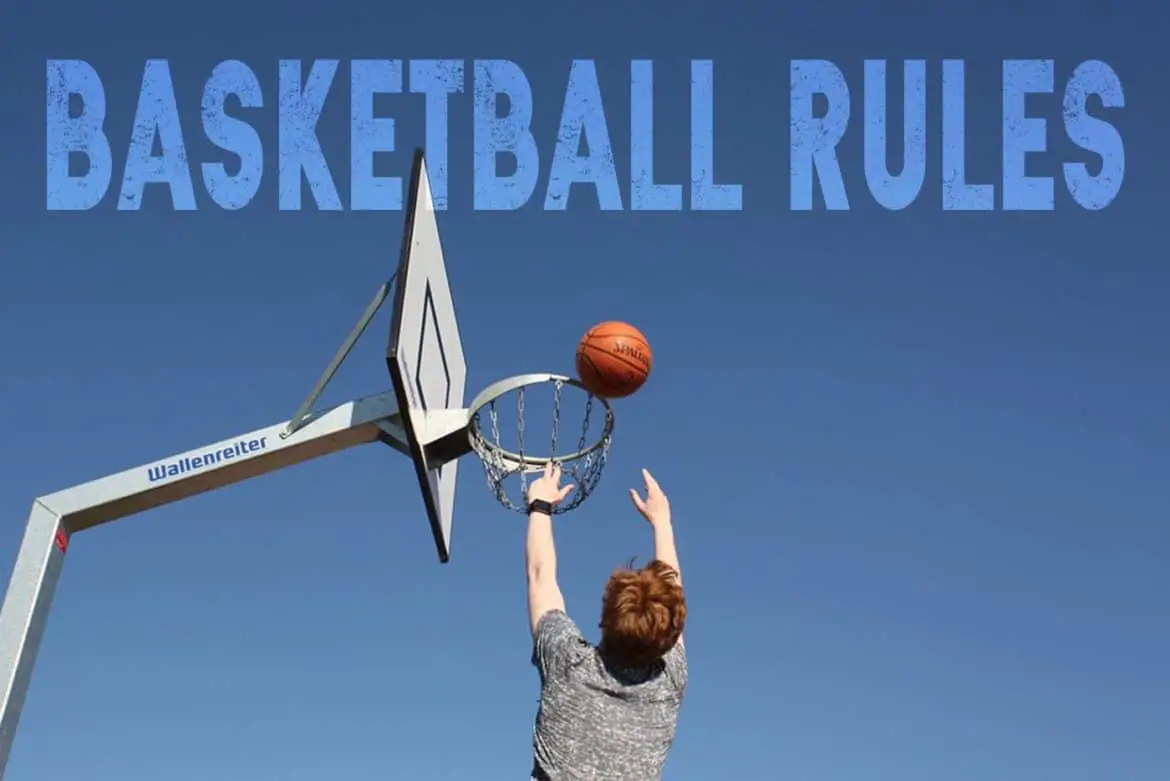Basketball is one sport that is near and dear to my heart. I had the privilege of playing college ball in Iowa back in ’88, with Emmaus Bible College of the NBCAA (National Bible College Athletics Association).
Unfortunately, I wasn’t good enough to continue towards my goal of the NBA, but hey, it was fun while it lasted, and I still love the game. Here’s an outline of some basic basketball rules to help you organize your recreation a bit.
What’s the Point?
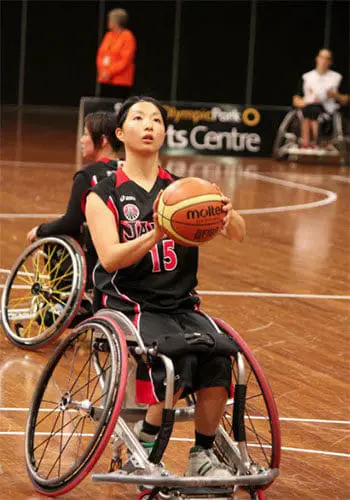
The concept of the game is that two teams of players compete against each other to end the game (based on a set time) with more points than their opponent.
Each team tries to plop a round, leather, bouncy ball (smaller than a beach ball and bigger than a baseball) into a metal ring mounted against a wall or on a self-standing brace, ten feet off the ground.
The ring (or hoop) is mounted parallel to the ground so that if a player throws the ball upward, gravity will be sufficient to pull the ball down through the hoop if the throw is accurate.
That’s about it, except that there are quite a few basketball rules that govern the actual play. Let’s look at them!
Basketball Rules of Play
As mentioned, two teams of five players square off in a timed game, and the team that can score the most points at the end of regulation is declared the winner. Teams score by putting the basketball through a metal ring that is connected to a backboard.
The ring is ten feet above the court’s surface. Teams can score either one, two or three points based upon the type of shot the offensive player is making either in regulation or a dead-ball situation.
The offense can move the ball toward the opponent’s basket by either passing or dribbling (bouncing). Once the ball crosses the center line of the court, the offense cannot return to that side of the floor.
If they do, the offensive team is called for a violation known as a backcourt violation or “over-and-back”.
Are You Dribbling?
One of the most often violated basketball rules pertains to dribbling (bouncing) the basketball. If a dribbling player picks up the basketball or a player receives a pass, they are essentially frozen with two exceptions.
First, the player receiving the pass may advance by dribbling. But if the dribble is picked up, the player can only move by rotating around one foot as it stays on the floor. This is called a pivot foot.
The pivot foot cannot be picked up unless the ball is shot, passed or dribbled. If the player in possession of the ball moves his pivot foot without releasing the basketball, then the referee will call a violation called “traveling.
A traveling violation can also be called if a player takes more than two steps when shooting or before dribbling the basketball.
Double dribble is a violation called when the player possessing the basketball dribbles, picks up the ball and then starts the dribble again. This is a turnover, and the opposing team gets the basketball for a throw-in.
Fouls are most typically called by the referees when it is determined that illegal contact has been made by a defensive player upon the body of an offensive player. In rarer occasions, an offensive player can be called for a foul against a defensive counterpart.
Technical fouls are called by the referees when a coach becomes unruly, or a player fouls another player with the intent of harming the individual.
When a technical or flagrant foul is called, the team that has been fouled gets a combination of free throws and the subsequent possession of the ball once play resumes.
Play Area (sounds like pre-school talk) !
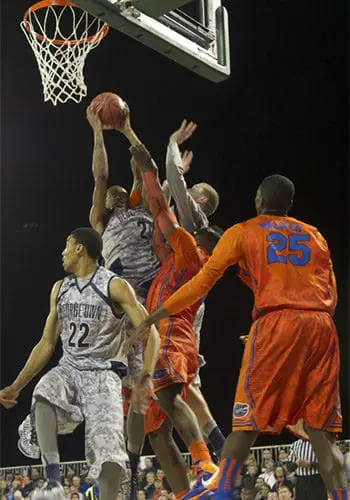
The play area or court has a boundary that runs around the floor that establishes a specific perimeter, inside of which is called “inbounds”, while outside of that perimeter is called “out-of-bounds”.
Basketballs that cross the sideline into the out-of-bounds area are declared dead by the sound of the official’s whistle, and the referee determines the team who will be awarded a throw-in.
If players of both teams hold the basketball at the same time during regulation play, the officials will call a jump ball. In high school and college, a possession arrow determines what team will get the ball for a throw-in.
In the NBA, the ball is tipped like the opening of a game.
Scoring
Scoring points can be made in one of three ways. Players can score either a two or three-point shot in regulation or a one-point shot via the free throw line.
Regulation scoring is when the ball goes through the hoop while the clock is running. Points can be scored from inside and outside the three-point line. This scoring occurs during a “live-ball” situation.
When the referee’s whistle blows, any infraction after this signal is commonly referred to as a “dead-ball.”
Free throws can be awarded after a defensive or loose ball foul is called. The same is not true of offensive fouls. In those instances, the defensive player is not awarded a trip to the free throw line.
Free throws are granted to offensive players who are fouled in the act of shooting. If the player makes the shot while being fouled, then the player is awarded an additional free throw on top of the made basket.
In each level of basketball, a team is allowed a specific number of fouls before the other side is in the “bonus.” When a team is in the bonus, and they are fouled they will receive free throws.
Referees can also call a goaltending infraction when a defensive player blocks the basketball on the path to the basket, and it is either in a downward flight and/or above the rim and has the possibility of entering the basket.
As in most sports, basketball rules can be a bit subjective, and the referees must do their best to determine the fairest course of action to take (or call to make) regarding goaltending.
Players cannot reach through the hoop ring to block a shot that is in this position as well. A defensive player can, however, legally block a shot from an offensive player as long as the ball is on an upward trajectory, and is below the level of the rim or hoop.
Within the NBA and NCAA basketball rules, there is a shot clock to prevent teams from holding onto the basketball during offensive possessions. In the NBA, the length of the shot clock is 24 seconds.
In the NCAA, the clock runs for 30 seconds. In both levels, the shot clock is reset during regulation when the ball comes in to contact with the rim.
Equipment
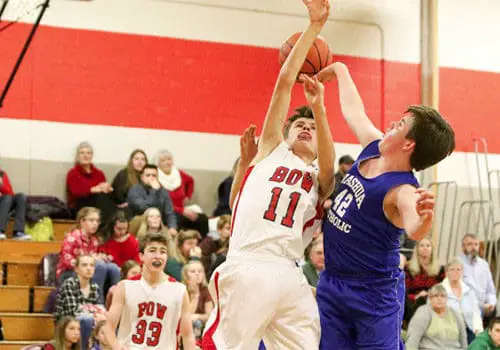
Basketball is a sport that can be played with little equipment or gear. Essential equipment required for the game is a hoop and a basketball.
The basket can vary in height for different levels, but in high school through the NBA, the basket sits at ten feet above the floor/playing surface.
Basketball rules are very specific when it comes to ball sizes. They vary in sizes due to levels as well as the gender of the players participating in the game.
In the upper levels of basketball such as the high school, college, and NBA, the ball is a uniform 29.5-inches in width. For women leagues, the width of the ball will vary from 27.5-to-29 inches.
Players wear specifically designed shoes to help with ankle support and soles that grip the floor for better control for stopping and cutting on the court.
Elite professional players typically are endorsed by popular brands of shoes and have the specific model they wear during games.
Uniforms consist of a sleeveless tank top with shorts. In most leagues, the shirt has to be tucked into the shorts during games. The top is sleeveless so that shoulders are without restriction and the player can shoot and rebound freely.
Surface of Play
It is of course, very helpful to have a playing surface upon which a ball can bounce freely and cleanly. Most typically, games are played in an indoor gymnasium with a hardwood floor.
Some facilities have different surfaces like specially designed plastic-based tiles or rubber. Some variations of the sport (usually much less formal scenarios) are played outdoors on pavement courts or other flat surfaces suitable for bouncing a ball.
Player Positions
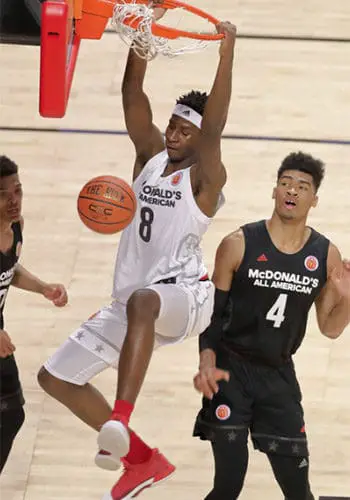
There are five positions on the floor with specially designated roles and attributes. Coaches may ask for players to perform different tasks than the typical understanding of the position.
The Point Guard position is given the task of bringing the ball down the floor to start the offense. Most coaches like their point guards to be quick and possess a court vision to penetrate defenses and make smart passes that allow playmakers on the floor to score.
The Shooting Guard is usually positioned on either the left or right wing of the floor. Coaches typically want their shooting guards to be strong defensively but also have the ability to shoot from long distances with accuracy.
Some coaches don’t mind sacrificing offensive ability in their shooting guards if their defensive skill set is strong.
The Small Forward is commonly one of the best athletes on the floor. They are tall and have the skill set to slash to the basket. Their shot works best from mid-range, but they can also score the occasional three-pointer.
The small forward helps on defense by aiding in the rebound game.
The Power Forward is large and versatile. With an emphasis on rebounding, the power forward floats around the free throw line and down closer to the basket (hoop) to help the team in offensive rebounding as well as scoring closer to the basket.
Power forwards are strong and can block access to opposing offensive players trying to dominate around the rim.
Finally, the Center is typically the tallest player on the floor. They control the lane and are usually the best rebounder on the floor due to their reach and extended height.
Since centers typically work around the goal, their field goal percentage is high as their shots are usually from a short distance.
Court Layout
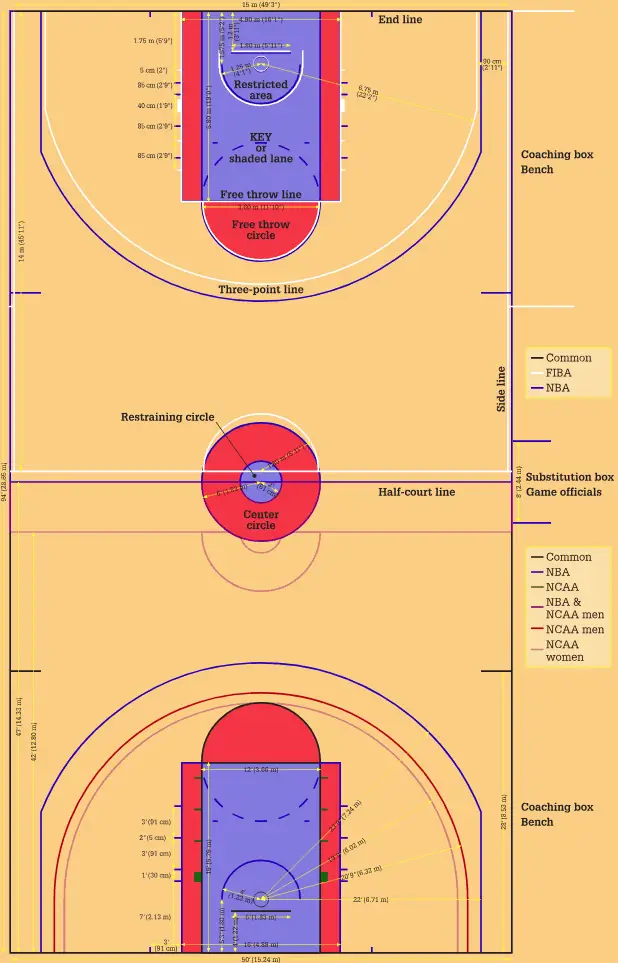
A basketball court in the upper levels of play measures 94-feet long and has a width of 50 feet. With lines covering the court, players shoot free throws at a range that rests 15 feet from the basket.
If there are discrepancies anywhere on the floor as the levels rise in competition, it is with the three-point line. In high school, the three-point line extends over five feet from the sideline underneath the basket.
Then the line continues in an arc to a distance of 19 feet 9 inches.
At the college level, basketball rules dictate that the three-point line kicks out slightly to 20 feet 9 inches. In international play, such as the Olympics, the line arcs at 22 feet 2 inches.
And finally, the NBA has the longest distance for their three-point field goal at 23 feet 9 inches.
Strategies
Strategies are no less important in basketball than in any other sport. Careers are made and destroyed based on strategic factors employed by both coaches and management.
Let’s look at some basic on-court strategies that are used fairly often at all levels of play (except super tiny kids who are barely able to hold a ball!).
Substitutions can be sent to the scorer’s table for entry at any time during regulation play by a coach, but the player can not enter the game until a dead ball.
Isolation is an offensive strategy when an offensive player is allowed room on the floor to isolate a defensive player. Weak defensive players will see isolation more over the course of a game than stronger defenders.
Strong offensive players will take advantage of these isolation situations against weaker defenders gaining space for easy jump shots or aggressive drives to the basket.
Man-to-Man Defense is when a defender picks one offensive individual player each to shadow during offensive possessions.
The responsibility of the defender is greater during man-to-man because they can be expected to run all over the entire court and can often be found in a poor situation to defend the basket if they are outmaneuvered by the quickness of their offensive counterpart.
Zone Defense is different than man-to-man as the defenders cover designated areas on the floor rather than specific players.
Zone defenses allow for more aggressive traps and pressure on the basketball and can force teams to stay on the perimeter and settle for longer and lower percentage shots.
However, counter-strategies by the offense can also find lots of holes and deficiencies in a zone defense.
Zone defenses also are less tiring (typically) on the defensive players, so they are often used by a team as a strategy to relieve excessive stress or fatigue and allow their own players to recover their stamina.
Full Court Press is a defense that extends to anywhere on the floor and is designed to maximize pressure on the offensive unit.
A full-court press can be played in either a zone or man-to-man style with areas on the floor that the defensive team will trap and attempt to force turnovers for easy baskets on the other end of the floor.
Full-court presses can be very effective, but like many things in life, there’s a risk/reward ratio.
The reward can be very high for the team to applies a full-court press, but the risks are high as well since the offense can often find large holes in the defending team since the defenders are not near their own basket, but all over the floor trying to get the ball.
Full-court presses are often used near the end of a game and usually by the team that is losing the match.
It’s used as a “we-have-nothing-to-lose” strategy since time is nearly gone, and without some strategy being applied, the losing team will have little chance of recovering to win the game.
Conclusion
Okay, when I read through this article, it sounded like basketball rules are super technical and complicated. In fact, like in many activities, players of the game seldom think of any basketball rules consciously.
They are just second nature, and the only time they are actually given attention is when there is a violation, and especially a violation that is being challenged by the offending team or player.
Basketball is one of the most popular sports in the world since it can be played with minimal gear and equipment. As such, it can be played all over the world – AND IT IS! Happy balling!
Oh, and if you’re wondering about what shoes to get for best performance, we’ve got you covered. Thinking about how to train for best performance and jumping ability? No problem, we can help!
If you’d like to improve your game by practicing at home, check out our recommendations for the best basketball net for your driveway.
In fact, we have so many articles on basketball, that you can just type “basketball” in the search bar at the top of this page and you’ll have more info on basketball and related products than you ever thought possible (in one place that is!).
Hey, are you a fan of King James? What about vintage Cavs jerseys and gear? If so, you can’t miss checking out some gear (just window shopping right?) HERE!

